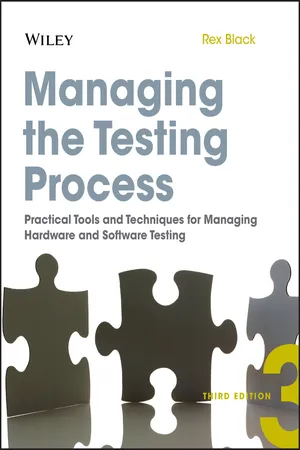
Managing the Testing Process
Practical Tools and Techniques for Managing Hardware and Software Testing
- English
- ePUB (mobile friendly)
- Available on iOS & Android
Managing the Testing Process
Practical Tools and Techniques for Managing Hardware and Software Testing
About this book
New edition of one of the most influential books on managing software and hardware testing
In this new edition of his top-selling book, Rex Black walks you through the steps necessary to manage rigorous testing programs of hardware and software. The preeminent expert in his field, Mr. Black draws upon years of experience as president of both the International and American Software Testing Qualifications boards to offer this extensive resource of all the standards, methods, and tools you'll need.
The book covers core testing concepts and thoroughly examines the best test management practices and tools of leading hardware and software vendors. Step-by-step guidelines and real-world scenarios help you follow all necessary processes and avoid mistakes.
- Producing high-quality computer hardware and software requires careful, professional testing; Managing the Testing Process, Third Edition explains how to achieve that by following a disciplined set of carefully managed and monitored practices and processes
- The book covers all standards, methods, and tools you need for projects large and small
- Presents the business case for testing products and reviews the author's latest test assessments
- Topics include agile testing methods, risk-based testing, IEEE standards, ISTQB certification, distributed and outsourced testing, and more
- Over 100 pages of new material and case studies have been added to this new edition
If you're responsible for managing testing in the real world, Managing the Testing Process, Third Edition is the valuable reference and guide you need.
Frequently asked questions
- Essential is ideal for learners and professionals who enjoy exploring a wide range of subjects. Access the Essential Library with 800,000+ trusted titles and best-sellers across business, personal growth, and the humanities. Includes unlimited reading time and Standard Read Aloud voice.
- Complete: Perfect for advanced learners and researchers needing full, unrestricted access. Unlock 1.4M+ books across hundreds of subjects, including academic and specialized titles. The Complete Plan also includes advanced features like Premium Read Aloud and Research Assistant.
Please note we cannot support devices running on iOS 13 and Android 7 or earlier. Learn more about using the app.
Information
Chapter 1
Defining What's on Your Plate: The Foundation of a Test Project
What You Might Test: The Extended Test Effort
From Microscope to Telescope: Test Granularity

Structural (White-Box) Tests
Behavioral (Black-Box) Tests
Live Tests
The Complementary and Continuous Nature of Test Granularity
A Stampede or a March? Test Phases
Table of contents
- Cover
- Table of Contents
- Title
- Copyright
- About the Author
- Credits
- Acknowledgments
- Introduction
- Chapter 1: Defining What's on Your Plate: The Foundation of a Test Project
- Chapter 2: Plotting and Presenting Your Course: The Test Plan
- Chapter 3: Test System Architecture, Cases, and Coverage
- Chapter 4: An Exciting Career in Entomology Awaits You: A Bug-Tracking Database
- Chapter 5: Managing Test Cases: The Test Tracking Spreadsheet
- Chapter 6: Tips and Tools for Crunch Mode: Managing the Dynamic
- Chapter 7: Stocking and Managing a Test Lab
- Chapter 8: Staffing and Managing a Test Team
- Chapter 9: The Triumph of Politics: Organizational Challenges for Test Managers
- Chapter 10: Involving Other Players: Distributed Testing, Outsourcing, and Related Topics
- Chapter 11: Economics of Testing: Fiscal Context
- Chapter 12: Testing Implications of Project and Process: Situational Context
- Appendices
- Glossary
- Index
- End User License Agreement